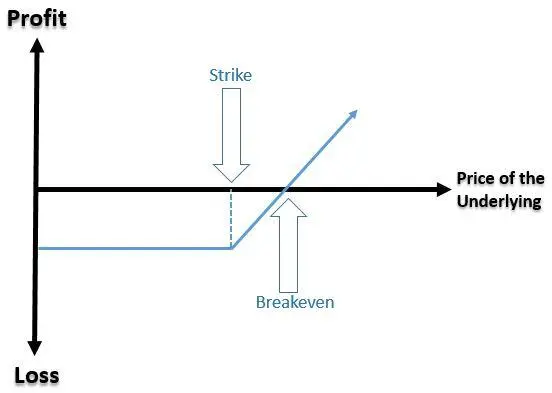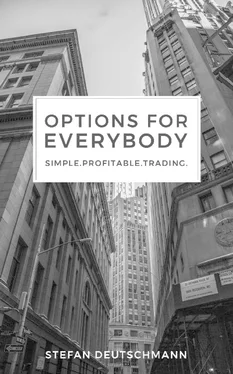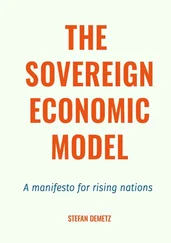Options are influenced by various factors (the "Greeks").
2.3 Buying or selling Options?
You have already gained a first insight into the world of options, the first types of contracts and what they contain. Now it's time to increase the speed a bit and deal with the really serious topics. Don't worry, everything will be explained to you in detail again and if you don't understand it on the first try, go back and take the time to go through the lines again. Remember: option trading is a marathon, not a sprint.
You have already learned that you can act as an option buyer. Logically, however, there must also be an opposing side, which you can of course take too. Let's start with a small table - this will make it clearer and easier to understand which rights and obligations we need to know as traders when it comes to buying or selling calls and puts. Remember that every trade has two sides. So you always have an opponent with whom you have to agree to trade. There are four basic options we can get involved with. We can buy calls and puts or sell calls and puts.

Figure 3 : Rights and obligations for buyers and sellers
In this case, the buyer of a call option has the right to buy the share at a certain price in the future. If you are now an option buyer, you pay money in the form of a premium. So if you pay for something, in return you get a right to make a decision in the future, to wanting to exercise an option or not. On the other hand, a put option buyer has the right to sell shares at a certain price in the future. In both cases, you pay money to the option seller so that you acquire a right and at the same time commit the counterparty.
On the other side of the table we have the option sellers. As option sellers, we have obligations because we have sold our rights for a fixed premium. As a seller you are obliged to sell or purchase shares at a certain price in the future. However, this only applies if the other party makes use of its right and you have to fulfil your obligation. In this case one speaks of being "assigned". But what is my advantage in selling rights if I can be assigned at any time during the contract term? We will discuss this in detail and at the end you will notice that the option seller's side is much more profitable and comfortable than the buyer's side.
For example, you have the option to conclude the option contract at any time, which will liquidate your obligation. I'll be a little ahead of you here. Let's say you're a seller, your option has already made 50% profit, so you buy back your own contract, which is worth much less than it used to be, of course. You keep the 50% of the premium and at the same time your obligation is released. Basically you have a lot of possibilities to manage your contracts in order not to be committed. You will get to know them all in the course of the book.
The obligation to buy/sell shares is only given if they expire or if they are assigned early. However, early assignment of your position only works for American-style options. In contrast, there are still so-called European options, which cannot be managed/closed or assigned during the contract period. With this type of option, the entire term is binding for both parties to the contract. However, these are of no interest to us and are therefore ignored. But now we want to take away your fear of being assigned. You don't have to panic to owe your counterpart 100 shares once. Assignments usually happen within the last week or the last few days of a contract term. However, we have sufficient possibilities to manage our contracts in advance so as not to let it get that far in the first place - you are going to learn these mechanics later.
Let's get back to the basics. As a seller, you now have an obligation. In the case of a put option, you have the obligation to buy shares from the option buyer, who will sell them to you at a predetermined price (strike). So if the put option buyer says that he will sell a stock to you at USD 50, you must buy the stock for USD 50 if the price has fallen to that price. If the stock continues to fall, you still have to pay the counterparty the agreed price (strike), even if the stocks are actually only worth USD 30, for example. Your intention as an option seller is, of course, that the stock remains worth more and does not fall to this level. In this case, the seller now receives money from the option buyer in the form of a premium. Do you remember? As a buyer you always had to pay this premium, as a seller you collect it immediately at the beginning of the contract.
Let's repeat what we've said. If you are a call option buyer, you hope in this case that the stock price will rise. This is your hope. You buy a call option in the expectation that the stock price will rise in the future. If you are a put option buyer, you hope the stock price will fall below your strike. When buying a call or put option, remember that you pay a premium to get a right. You are dependent on the stock not only moving, but also on your preferred bill. Otherwise you not only lose the premium, you also make no profit. By claiming this premium as a seller, you give yourself the rights to commit yourself. However, you don't care what the share does. It can rise, fall or simply not move at all. As long as your strike price is not reached, you keep the premium.
So as option sellers, we have more opportunities to make money than we have as buyers. This will become particularly clear in the course of the book. We have not yet talked about what it looks like as a seller with profits and losses. As you probably already suspect, the distribution in this case is exactly the other way around. As a seller, you cannot earn more than the premium received, but you can lose significantly more. But don't worry, we'll take care of it so that this doesn't happen. First of all, it is important that you understand the profit/loss charts. These are essential because each strategy offers you different graphs. So you have to understand the basics once, after that everything is as good as self-explanatory.
Remember:
There are four basic option contracts (long or short / calls and puts).
As a buyer you acquire a right, but as a seller you commit yourself.
As a seller you have many possibilities to manage profits and losses in order to be profitable in the long run.
As a seller of puts, you have to buy shares at a certain price (strike).
As a seller of calls, you must deliver shares at a certain price (strike).
2.4 Profit Loss (PL) Diagrams
It is really essential to understand profit/loss (P/L) diagrams, because they are the key element in understanding where to make money, where to break even, and where and how far the loss zone extends. It is important to understand how they work because they can help you understand complex strategies and how to apply them to the underlying.

Figure 4 : P/L-Diagram (Long-Call)
Here you can see a basic P/L diagram, which can be applied to all strategies accordingly. On the Y-axis you see a straight line, where everything above 0 represents a profit and everything below 0 represents a loss. The X-axis represents the price of the underlying. The break even is the point at which the chart moves from a loss to a profit zone.
Ultimately, this means nothing more than a representation of where the price of the underlying stock must be on the expiration date for you to be profitable. That's basically what we're looking at. The bluish line represents the strategy. Different strategies of course have different charts, because they are profitable at different times, or contain a limitation of the potential loss or not. In the course of this book you will see many more such graphs. Just when I teach you the individual strategies, they play an overriding role.
Читать дальше














